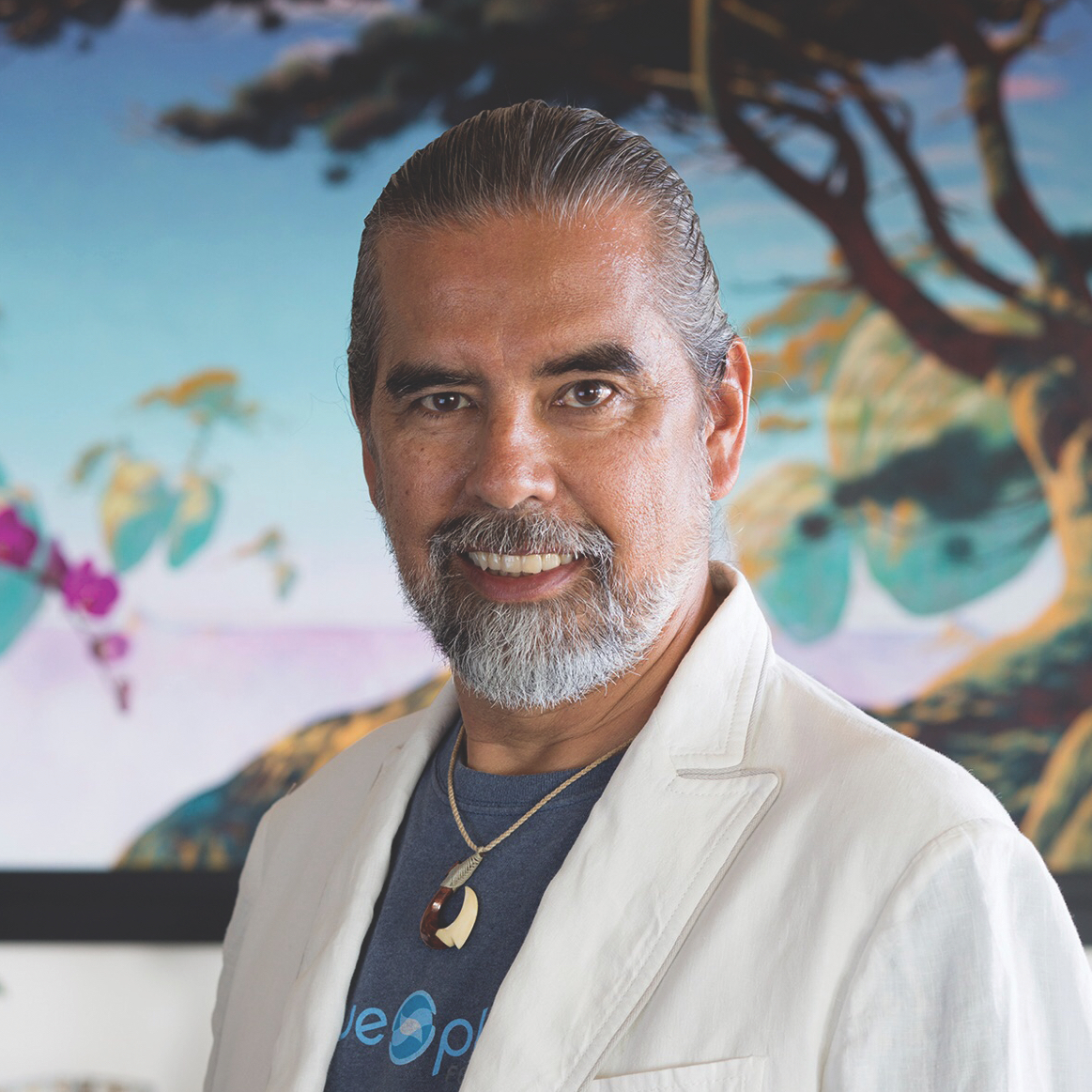HENK ROGERS
IMA Founder, Chairman, & Entrepreneur
Henk B. Rogers is a Dutch-born entrepreneur, and a clean energy and space exploration visionary who has dedicated the past decade of his career to the research, development, advocacy, and implementation of renewable energy sources in his adopted home of Hawai‘i and beyond.
After coming to Hawai‘i at 18, Rogers fell in love with the landscape, the people, and culture. Rogers’ early career was spent in Japan as a videogame designer and publisher, before he secured the international rights for the blockbuster game, Tetris, and founded the company, Blue Planet Software.
In 2007, after learning about the global threat of man-made environmental damage, Rogers founded the Blue Planet Foundation. Its goal: to end the world’s dependence on fossil fuels. Blue Planet’s efforts led to Hawai‘i Governor David Ige signing a bill in 2015 that directed the state’s utilities to solely generate 100-percent of electricity sales from completely renewable sources by 2045. Hawai‘i became the first state to enact legislation of this kind in the United States. Rogers went on to create Blue Planet Energy Systems and developed Blue Ion, an industry-leading battery technology with proprietary system architecture and energy management software.
Now Rogers turns to his next mission: building a backup of life on Earth. Rogers is the Founder of the International MoonBase Alliance, Chairman of the Pacific International Space Center for Exploration Systems (PISCES), and on the Board of Governors of the National Space Society (NSS). He also owns HI-SEAS, a 1,200 square-foot Mars habitat where six crew members live in Mars-like conditions for up to 12 months to realistically simulate exploration of the Red Planet and help NASA and other space agencies learn from their experiences.
INTERVIEW WITH HENK ROGERS
The last time we went to the moon was in 1972. Why return now, specifically? Have we needed all this time to perfect the technology or acquire the political willpower or was it spurred by the discovery of water on the Moon?
I think it’s a combination of all those things. Going to the Moon in the 1960s was about beating the other guys, the Soviets, which is the wrong motivation to do something. And once we won that race, we lost our motivation. What’s happening now is we’re coming to the realization that we actually do need to get off the planet. It’s a small world and when you combine that with more people, I think it’s time to move on. We’ve pretty much explored every place on Earth; we’ve gone out to every little corner. It’s in our genes that we want to go places.
Then there’s the technology; we went from having space agencies like NASA doing everything — which, when they do something, it’s super expensive — to having the private sector do it, which ends up being a way smaller cost because they operate differently. Private sector companies can be faster and more nimble because they have a different way of thinking about these things. You can see the price dropping significantly, which means that more and more companies, people are going to get to go to the Moon.
Returning now also allows us access to valuable resources. When we went in the past, it was all about accomplishing just a little bit of scientific research and there’s a limit to how much people want to spend for that. Moving forward, the science will continue but it’ll be driven by commerce, then tourism. All those things add up to having a permanent settlement on the Moon. When NASA thinks about a MoonBase now, they think of the ISS, which cost something like $150 billion dollars. But that’s not how we should be thinking about it. Take in 3D printing, new technology, sending robots to do the work and not people, not building a base literally on the Moon but transporting it there, and using additional resources from the Moon itself. The price tag should be in the hundreds of millions, not the hundreds of billions.
You were 16 when Apollo 11 landed on the Moon. At the time, did you know what it meant to the country? 1969 was a tumultuous time in the world, especially in the United States. Did the Moon landing help to unite people?
At that time, there was the Vietnam War, the civil rights movement, and so on. The world was in turmoil — but when we stepped on the Moon, everybody kind of took a step back and said, wow. It was inspirational and a moment where all of humanity could celebrate this human accomplishment. That’s what space represents. So Elon Musk sending his Falcon Heavy, that’s an accomplishment for all humankind because all these agencies and companies, they don’t operate in a vacuum.
Going from video games to sustainable energy to space travel. How did the idea of going to the Moon first appear on your radar? You took over as Chairman of PISCES in 2014. What’s your personal passion with outer space?
I sold one of my companies in 2005 and a month later, I had a massive heart attack. It wasn’t like they had to crack open my chest but if I hadn’t been within 15 minutes of an angioplasty, I would’ve died that day; I had 100% blockage in the biggest artery of my heart. When I was in the back of the ambulance, the first thing I thought was, what? I haven’t spent any of the money yet from selling my company. I’ve still got work to do. I was determined not to die that day and after that, I found my mission in life.
Mission number one is to end the use of carbon-based fuel, which is about saving our environment for future generations. The second thing was to end the war. It wasn’t just about the deaths — more people die in car accidents every year than they die in war — it’s also about the spending and the waste. We spent as much money in Afghanistan as we spent in the entire history of NASA. Look at everything we gained from the space program. What did we get out of Afghanistan? Nothing. What did the Afghans get out of it? Nothing. It was a horrendous waste and a tragedy.
My third mission is to make a backup of life on Earth. 65 million years ago, the dinosaurs went away. Which in terms of the age of the 5 billion-year-old solar system, 65 million years is very recent. They didn’t know how to get off the planet. But we know better and need to do better. When we get to the Moon, it’ll also force us to live sustainably because we can’t be throwing out garbage when it takes a million dollars per kilo to send something up there. Everything will have to be re-used or reprinted or recycled or something else. So by learning to live on the Moon and Mars and other planets, we’ll learn how to live sustainably here on Earth.
The surface of Mauna Loa is similar to that of the Moon and Mars, which is why it makes sense to build the proposed Moon habitat there. But in the future, will Hawai‘i become a 21st century Cape Canaveral? How does placing a habitat on the Big Island benefit Hawai‘i?
The initial funding for research like this will come from the space program and it’ll be invented here in Hawai‘i. So we’ll have the intellectual property and expertise on how to do these things in Hawai‘i that we can export from there, to use in the rest of the world. It’ll be interesting to visit the first prototype MoonBase in Hawai‘i, sure, but it’s the science that will benefit the Islands.
What are the obstacles to going to the Moon? Is it a matter of just needing enough money? Are there political or societal elements that have to be in place? What’s needed most at this point?
I don’t think there’s anything in the way at this point. Political will, maybe. Eventually, China will one day say they’re going, the U.S. will say we’re going, the ESA will say they’re going. Elon Musk has made it clear that with or without the rest of the world, he’s going. He wants to go to Mars and he’s made it clear from the very beginning of SpaceX that’s his target. The Moon is just a stepping stone or a place to practice.
It’s all already happening and technology is on a curve. There are robotics now with swarm technology, meaning there’s the ability for lots of drones to cooperate together even without a central intelligence, they can all just talk together and work in formation without it having to be a planned thing. So the A.I. and the robotics are there or close to being there, 3D printing is reaching a crescendo, and everything is happening at the same time so it’s all coming together naturally.
There’s a joke in the novel Fight Club that says when deep space exploration ramps up, it’ll be the corporations that name everything: the IBM Stellar Sphere, the Microsoft Galaxy, Planet Starbucks. Moving forward with a MoonBase, will access be limited to nations or nonprofit organizations? What about private companies? And will they share research or collaborate similar to ISS? Should there be parameters or guidelines to how we use the Moon?
[Laughs] Really, it’s whoever can get there. If I had enough money and decided to build a MoonBase and I went there and did it, can anyone say no?
Maybe somebody will say, you can’t launch that rocket out of my country. But then there are a lot of countries that would love to have it. Once you get to the Moon, nobody owns that space. Another way to look at it is like the West India Company, where government played a part in outreach but it was really this private company looking for resources from the new world that played a bigger role.
It’s about human migration. It won’t happen until the price of getting to the Moon goes down and becomes more accessible. But at some point, it’ll be like an airplane ticket and humanity will be on two worlds, permanently.

